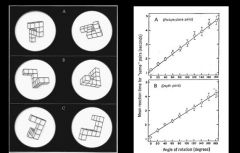![]()
![]()
![]()
Use LEFT and RIGHT arrow keys to navigate between flashcards;
Use UP and DOWN arrow keys to flip the card;
H to show hint;
A reads text to speech;
19 Cards in this Set
- Front
- Back
|
How did Alan Turing define cognition? |
Computational, rational and linguistic processes |
|
|
What are the three terms associated with a more contemporary, broader definition of cognition? |
Dynamic, Embodied and Situated |
|
|
What is limiting in defining cognition as a depository of knowledge (data base)? |
it is an activity, so it is also the acquisition, organisation and use of that knowledge to goal-directed behaviour *learning and memory |
|
|
Was Classical Cognition interested in the hardware, software or both? |
The software (the process and model, it didn't matter where it occurred and in what it occurred) |
|
|
What was the human brain and mind referred to in terms of hardware and software? |
Brain = hardware Mind = software |
|
|
What is "mentalese"? |
The language of thought |
|
|
What is the mental representation of the Classical Model? |
manipulation of symbols according to syntactic rules for combining those symbols.
*to either delineate or associate concepts Properties and relationships "in" "has a .." "not" "and" "or" |
|
|
What is the Propositional Representation? |
[Relationship between elements] [subject element], [object element] E.g. UNDER (CAT, TABLE) can be done in two ways “The cat is under the table”[better] or “The table is above the cat" [not as good, not as simple] |
|
|
In this model, P (x,y) what is the predicate? |
Predicate is the Argument which takes place outside the brackets |
|
|
In this model, P (x,y), what does x and y symbolise? |
the RELATIONSHIP/PROPERTY (SUBJECT, OBJECT, etc) which is in the brackets |
|
|
Are Semantic Networks symbolic or analogous representations? |
Symbolic |
|
|
Who challenged the concept of symbolic representations and what experiment did they conduct? |

Shepard and Metzler (1971) with mental imagery and mental rotation.
|
|
|
In relation to the mental rotation, what were the relationships (x-axis and y-axis) in the linear graph? |
X - time it takes to rotate image Y - Response time |
|
|
What representation can explain imagery? |
Analogue Representation |
|
|
What is dynamic cognition? |
Unfolds over time and space(continuous, not discrete - Think computer-mouse-tracking)
Cognition inseparable from sensing, thinking, acting in real time |
|
|
What is the advantage of using online experimental measures such as eye-tracking and computer-mouse-tracking (instead of outcome-based measures such as reaction time and accuracy)? |
More possible to see the mental activity in action |
|
|
What is embodied cognition? |
That we can't understand abstract thought without going through the more concrete processes. So we can't understand the concept of justice, without first understanding more physical, concrete (embodied) concept of balance (BASIC) *links well with Piaget's motor-perception stage of cognitive development in children |
|
|
What is situated cognition? |
Our cognition is not just in the mind, but is mapped out according to our physical space. The physical environment helps us to think E.g. When we want to reduce cognitive load, we write notes/lists to ourselves |
|
|
What did Leonardo have that mimics developmental cognitive processes in children? |
1. Object appraisal mechanism tags object as novel
2. Triggers mild anxiety response and expressions 3. Promotes a human response to emotion 4. Attentional system monitors human facial expressions and looks back to object – sharing attention 5. Picks up signals from tone of voice 6. Empathic mechanism mirrors human facial expressions to simulate emotion in itself 7. Change in emotional state triggers long-term memory response for object, tagged with socially referenced emotional information |

